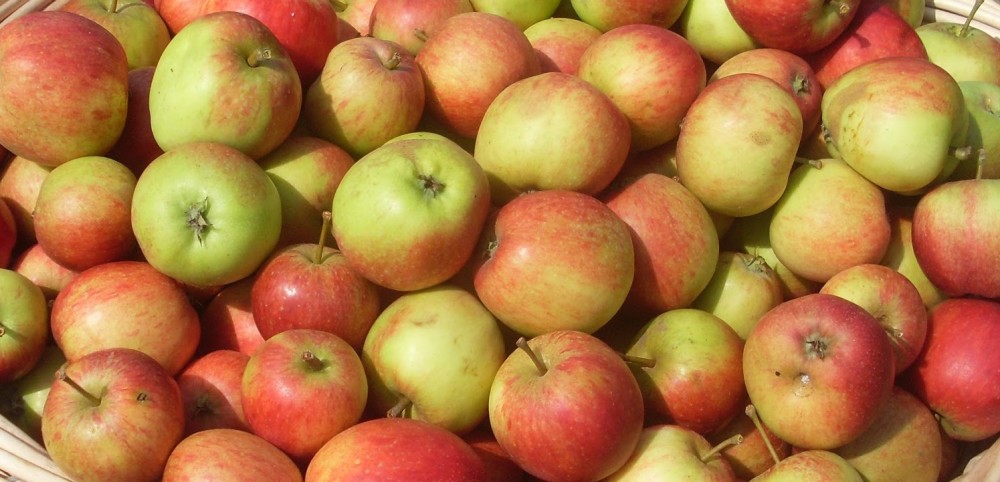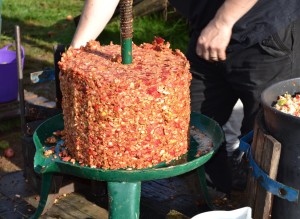Fruit harvest

Whilst it is wonderful to get a glut of fruit to gorge on in autumn, you might like to save some for later in the year.
Jump to: Thinning fruit | Harvesting fruit | Storing fruit | Excess fruit
Thinning fruit
Unlike the brittle wood of plums and gages which might need supporting, apple and pear trees rarely shed limbs due to a bumper crop although the branches can droop dramatically. This is probably a successful evolutionary development as it helps animals reach and disperse the seed. If pollination is good, most varieties will produce lots of small apples. This is also a result of evolution as more apples equals more opportunities for seed dispersal.
Because we prefer fewer, larger apples, we often have to thin the crop which will usually result in larger healthier fruit, often with reduced chances of pest or disease infection. With fully grown standard trees it is difficult to thin the fruit at the crown, but any tresses you can reach to thin will improve the fruit quality locally.
Fruit thinning should be done at the point that your immature fruits are roughly thumbnail sized. At this point of development the cells within the fruit are still dividing, so the extra nutrients being channelled into the remaining ones will result in larger healthier fruit. If you thin fruit too much later than this, the fruit cells will have stopped dividing, and although they will still get a lot bigger as they mature, this will be through the existing cells filling and expanding.
Remove first any damaged or nibbled ones, then thin to two fruit per blossom tress, taking out the centre fruit, known as the ‘king fruit’. The centre fruit of the tress tends to be larger and have courser flesh and is generally less good in storage. Once the centre fruit is removed, thin back to the two largest remaining fruit per tress.
Use secateurs to thin your fruit rather than pulling them off, as sometimes pulling the stalk off can weaken the base and can cause the other fruit to drop off too.
Thinning also has the benefit of reducing the risk of biennial bearing in those varieties prone to cropping every other year.
Harvesting fruit
What you intend to do with your fruit will determine how best to harvest your bounty.
Any fruit that you intend to store must be carefully selected and hand picked, do this by lifting and gently twisting each fruit separately. If they are ready this will be enough to separate them from the tree, if they are stubborn to remove, this is often a sign that they are not yet quite ripe. Windfall fruit are generally great for eating and cooking although won’t store too long and any fruit used for brewing can happily be shaken off the tree.
Take care not to damage the branches when you shake, they will be heavy with fruit and so more easily damaged, however any ripe fruit tends to come off with a gentle shake. Consider leaving the rest on the tree, the wildlife in your orchard will appreciate this over the winter, and it’s not worth damaging your tree to get every last bit of fruit!
Storing fruit
By late summer/autumn you may find you have a glut of fruit from your orchard. Whilst this is a wonderful time to gorge on this natural bounty, you might find that you’d like to save some for later. Whilst the best way of prolonging the ‘fresh’ fruit season is to leave the fruit on the tree and eat them as you go, you can also store fruit so that it can be enjoyed at least until Christmas.
Some fruits lend themselves better to storage and others are actually improved by periods of storage in which they continue maturing to reach their peak flavour.
Apples lend themselves particularly well to long term storage, and almost any variety will keep for up to three months under the right conditions. However some varieties are better keepers than others, and will even improve in flavour and texture under storage. Generally late ripening apples with thicker skin and less sweet fruit store well.
Many pear varieties can also store well using the following guidelines, but require more frequent checking as they can change from unripe, to ripe to spoiled remarkably quickly.

Cider pressing apple ‘cake’ – Lowri Watkins
The main causes of apple spoilage are time, bruises and contact with another apple that has a rotten spot. Any fruits that you intend on storing need to be un-bruised, undamaged, and entirely intact. Any imperfection in the skin of your fruit will result in it rotting and potentially spoiling any fruits you are storing with it. For this reason all apples you put into storage should be hand-picked and treated carefully. Any windfall apples will have been bruised internally and will not store so long. Check your apples for soft spots, and any cuts or holes in the skin. Any fruit that is not ‘perfect’ should be eaten/cooked/juiced rather than stored.
As with pear, plum and other fruits, cooked apple can be frozen for storage if you have the freezer space. Whole raw fruits cannot be stored in this way as freezing bursts the cells, spoiling the texture. If you have more fruit than you can eat or store, pear and apple juice can be pasteurised, frozen or brewed into cider or perry.
Fruits are best stored under conditions that are:
- Frost free
- Free from pests that will eat them (mice, rats)
- Cool
- Slightly humid
- Dark
- Ventilated
This could be a shed, a cellar or a garage. Fruit storing shelves are available but you can also use things such as shallow cardboard boxes or wooden crates. Store fruits in single layer, without any touching each other. Loosely wrapping each fruit in a sheet of black and white printed newspaper can extend their storage life.
It is best to store boxes of fruit variety by variety, as they tend to mature at similar rates and so can easily be removed to eat when ready.
Check stored fruit regularly, and remove any that show signs of rot or disease as theses threaten to spoil the whole lot.
Pears need more regular checking than apples as they move from unripe to overripe quite quickly. When pears approach peak ripeness their skin will change colour slightly. At this point remove them from storage, leave them a couple of days and use. When ripe, pears release gasses that speed up the ripening of your other fruits and may cause spoilage.
Still got more fruit than you need?
There is a limit to how much fruit you can eat or store yourself and sometimes your orchard will provide more than this. Each year tonnes of unharvested fruit rots in orchards and whilst some of this is gratefully eaten by orchard wildlife, much still goes to waste.
If you have spare fruit from your harvest… Info by region aims.
